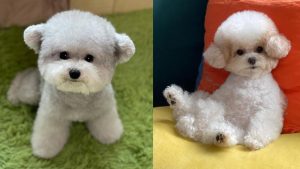What do you all know about the term “play bow”? Not many of you would be aware of this term, but if you are a dog lover, it is no surprise that many of you must be well aware of this.
A play bow is generally a form of the dog’s body language.
It is a way wherein dogs go on to communicate with people and various other animals. More specifically, it is the way of saying by your dog, “Let’s play!”
This article looks forward to Understanding Dog Body Language: Play Bow.
The Posture – Play Bow Dog
If you have ever been around dogs in your life, you would have probably noticed the play bow. It is a simple posture that dogs of all ages, sizes, and the breed go on to take when they look to have fun.
The play bow posture can be seen when the dog stretches the front legs out right in front and leans down on elbows. This brings the chest lower to the ground, making it look like the dog is almost lying down.
However, the rear end stays up in the air. It is frequently accompanied by a little bark or a big doggie grin.
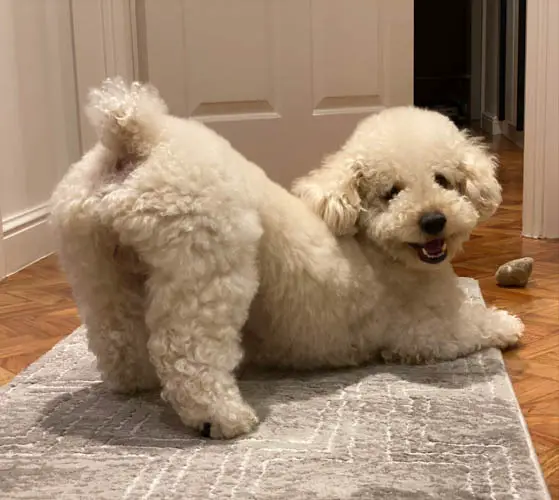
Meaning Dog Play Bow
As the name suggests, play Bow, in a simple meaning, is the dog’s style of trying to engage another dog, human companion, or animal, to play.
Their style allows you to know that whatever they are doing is nothing but just for fun and the games. This play bow is a pretty essential and integral part of social interaction among dogs.
When the dog generally meets some other dog for the first time, he may use this play bow to let that dog know that his intentions are all friendly.
Post this, the dogs are very likely to get together to play. At times, they’ll bow when another dog is tired of playing while the other dog would want to keep the game going.
Various dog behaviorists assume and believe that this play bow is also a style to signal that no matter what actions they go on to take the post, the Bow is indeed going to be friendly.
Eventually, dog play can get quite rough because of lots of noise, ear nibbles, body checks, and much more. The Bow generally takes any aggression away from the actions to follow.
If you are still not sure whether the dogs are fun-loving to play with or they are to begin a fight, you may look for the play bows.
If you witness both the dogs with their chest almost down to the ground and their rear ends staying in the air, chances are very high that they are playing.
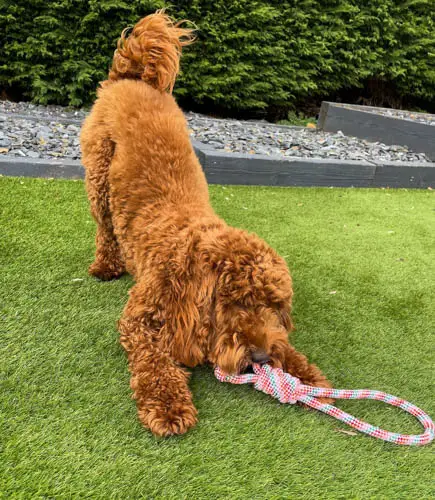
Speaking The Dog Language
The dog owners can generally tap into the pet’s natural communication simply by using the play bow themselves.
Indeed, it is a great way to get the pup excited about playtime and encourage regular and healthy exercise.
You could think that it may make you look dumb and foolish, but nothing is too big for you to do to make your dog feel loved because while doing so, you are taking a step towards speaking your dog’s language!
There exist a couple of ways wherein you can play Bow to the dog. The pretty obvious one is easy: you get down on your all fours, stretch your arms right in front of you, lean on your elbows, and stick your rear end up in the air.
Probably, a great style to grab your dog’s attention o the soft grass or in your house. The next way is when you can play Bow is in a standing position.
This might be easier under certain situations and for a few people, though it is less obvious, especially in public settings such as parks.
All you need to do is drop down your chest, bend a little by the hips, and go on to spread those arms out.
If you opt to do a secondary action such as run for the game of throwing a ball or chasing a ball, the dog will pretty easily get the hint.
The key to a successful way of pulling off the play bow is no matter what way you do it, and it has to be swift in your motions.
You can watch your dog when it is going to bow next time, and you will witness sharp movements, a lot of excitement, and a little hop. The endpoint is “the better you would mimic this, the clearer- “let’s play” indication will be.
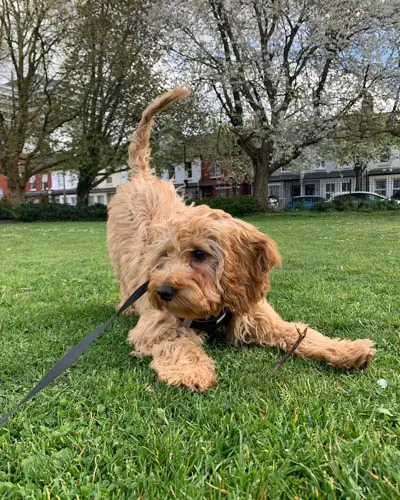
How Do You Train Your Dog to Take A Bow
Have you ever gone on to witness a dog taking a bow in the cue? It is pretty adorable. The dogs generally enjoy the tricks as they derive loads of positive attention.
Only if one can go on to train the dog to sit or stay, one can very easily train their dog to go on to take a bow on every command as well.
When taking a bow, your dog would be stretching the front legs out right in front and leaning down on elbows.
This brings the chest lower to the ground, making it look like the dog is almost lying down. However, the rear end stays up in the air. This is indeed the perfect and the best finishing touch.
All you require to train your dog is to take a bow and a few treats. You would also wish to possess a clicker on hand when you utilize clicker training as a part of the dog’s training.
Begin With Standing Up
Begin with the dog standing up tall on all four feet. This is helpful when your dog can go on to stand on your command.
If it still has not mastered this basic dog command, you would like to work on it first before moving on to another step, i.e., the second step.
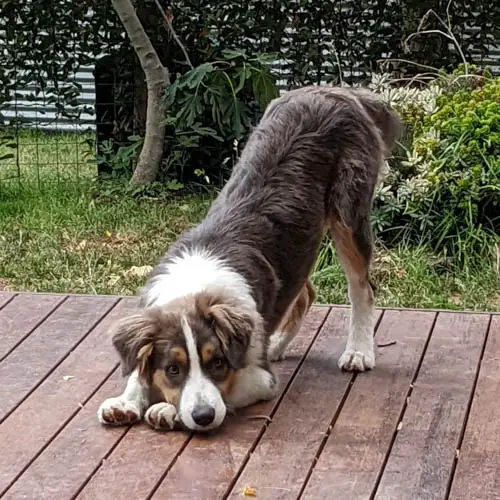
You May Use A Treat To Lower Your Dog
You can hold a treat right at the tip of the dog’s nose, and you may slowly move it downwards, holding it pretty close to the dog’s body.
Doing this, you will be using a treat to lure the dog down until its elbows are well on the floor with the hindquarters staying up.
Back To Standing
Hold the dog in that bow posture for a few seconds, then use that treat to lure it back while getting into the standing position.
Rewarding the Bow Helps
Once your dog finishes the Bow and is going to stand up, say “good” or “yes,” or you may click your clicker and offer your dog the treat.
Once the dog seems to be understanding the action, you may add the word “bow” before you go through steps 2 and 3 again and continue to practice the bow command, which will eventually help your dog master the posture along with you in Understanding Dog Body Language: Play Bow.


